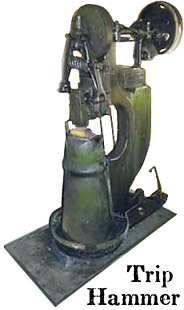Trip Hammers
Trip Hammers are Hammers that are commonly used in forging metals.
History
In ancient China, the trip hammer evolved out of the use of the pestle and mortar, which in turn gave rise to the treadle-operated tilt-hammer . The latter was a simple device employing a lever and fulcrum (operated by pressure applied by the weight of one's foot to one end), which featured a series of catches or lugs on the main revolving shaft as well. This device enabled the labor of pounding, often in the decorticating and polishing of grain, and avoided manual use of pounding with hand and arm. Although historians assert that its origins may span as far back as the Zhou Dynasty (1050 BC–221 BC), the earliest texts to describe the device are the Ji Jiu Pian dictionary of 40 BC, Yang Xiong's text known as the Fangyan of 15 BC, as well as the Xin Lun written by Huan Tan about 20 AD (during the usurpation of Wang Mang). The latter book states that the legendary mythological king known as Fu Xi was the one responsible for the pestle and mortar (which evolved into the tilt-hammer and then trip hammer device). With his description, it is seen that the out-of-date Chinese term for pestle and mortar would soon be replaced with the Chinese term for the water-powered trip-hammer. The Han Dynasty scholar and poet Ma Rong (79–166 AD) mentioned in one of his poems of hammers "pounding in the water-echoing caves". As described in the Hou Han Shu, in 129 AD the official Yu Xu gave a report to Emperor Shun of Han that trip hammers were being exported from Han China to the Western Qiang people by way of canals through the Qilian Mountains.In his Rou Xing Lun, the government official Kong Rong (153–208 AD) remarked that the invention of the trip hammer was an excellent example of a product created by intelligent men during his own age (comparing the relative achievements of the sages of old). During the 3rd century AD, the high government official and engineer Du Yu established the use of combined trip hammer batteries , which employed several shafts that were arranged to work off one large waterwheel. In Chinese texts of the 4th century, there are written accounts of men possessing and operating hundreds of trip hammer machines, such as the venerable mathematician Wang Rong (died 306 AD), Deng Yu (died 326 AD), and Shi Chong (died 300 AD), responsible for the operation of hundreds of trip hammers in over thirty governmental districts throughout China. There are numerous references to trip hammers during the Tang Dynasty (618–907 AD) and Song Dynasty (960–1279), and there are Ming Dynasty (1368–1644) references that report the use of trip hammers in papermills of Fujian Province.
Although Chinese trip hammers in China were sometimes powered by the more efficient vertical-set waterwheel, the Chinese often employed the horizontal-set waterwheel in operating trip hammers, along with recumbent hammers. The recumbent hammer was found in Chinese illustrations by 1313 AD, with the publishing of Wang Zhen's Nong Shu book on ancient and contemporary (medieval) metallurgy in China. There were also illustrations of trip hammers in an encyclopedia of 1637, written by Song Yingxing (1587–1666).
Video
